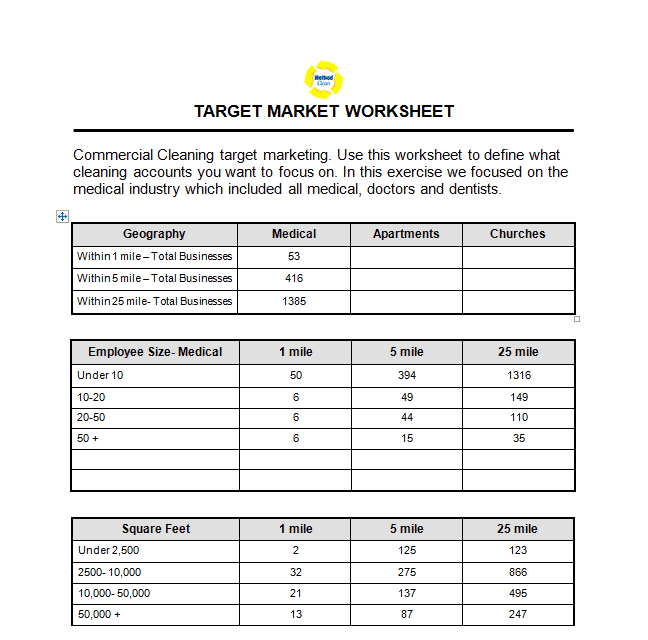What Is the Best Target Market for Commercial Cleaning Services?
🎯 Who should you target? That’s the #1 question commercial cleaning businesses ask when trying to grow consistently. With over 100,000 cleaning companies across 90,000 towns in the U.S., the options can feel endless.
💡 Instead of marketing to everyone, let’s create a focused list of ideal business types — the ones most likely to convert and stay loyal.
This isn’t just a strategy—it’s the foundation of your entire growth engine:
- 📝 Use it to build a marketing plan for your cleaning business.
- 📈 Align it with your website SEO and design strategy.
- 📊 Create repeatable sales processes that scale your business predictably.
In this post, we’ll walk you through the 3 key segmentation tools—geography, employee size, and square footage—to define your perfect commercial cleaning client.
✅ Plus, you’ll get a downloadable worksheet to start building your list today.
Why Target Market Strategy Matters
Marketing to “Everyone” Doesn’t Work
Trying to reach every business spreads your budget thin. Focusing on niche segments brings better ROI and qualified leads.
Focus Builds Predictable Leads
Specializing in select industries allows you to refine messaging, close more deals, and grow with consistency.
Retention Costs Less Than Acquisition
CRM principles show it's 5–8x cheaper to retain customers. Targeting the right clients increases long-term profitability.
How to Build a Target Market Worksheet
Watch this step-by-step tutorial on creating a focused, profitable target market list for your commercial cleaning business.
How to Segment Your Market Strategically
Create smarter marketing campaigns by targeting your ideal commercial cleaning clients using three core filters: location, employee count, and cleanable square footage.
1. Use Geographic Radius as Your Starting Point
Start by defining your service area. Begin with a small radius (1–5 miles) from your office location and gradually expand. This helps you keep routes efficient and costs down.
Pro tip: Use online tools like Google Maps or radius targeting apps to count how many businesses fall within each zone.
2. Segment by Employee Size
Employee count helps estimate how complex the job will be. Fewer than 10 employees? You’re likely looking at weekly or bi-weekly visits. Larger headcounts may mean daily cleaning is needed.
This simple variable gives you insight into service frequency and potential revenue per client.
3. Evaluate Cleanable Square Footage
Total square footage can be misleading — a 10,000 sq. ft. building may only have 2,000 sq. ft. of cleanable space if the rest is warehouse. Focus on the carpeted, tiled, or office areas that actually need cleaning.
Segment your prospects by estimated cleanable space: small (under 2,500 sq. ft.), medium (2,500–10,000 sq. ft.), and large (10,000+).
Examples of Profitable Markets
Certain business types consistently produce profitable, repeat commercial cleaning accounts. Use these segments to prioritize your outreach and build a high-value customer base. For deeper strategy, read our full guide to building customer profiles.
Medical
Ideal Clients: Clinics, Dentists, Nursing Homes
Why It Works: High standards, regular traffic, cleaning frequency often 3–5x/week
Professional Services
Ideal Clients: Law Firms, Accountants, Architects
Why It Works: Low-maintenance spaces, recurring weekly schedules, easy to upsell
Industrial & Distribution
Ideal Clients: Warehouses, Manufacturers, Logistics Hubs
Why It Works: Grouped needs, large square footage, often includes floor/tile services
Secondary Niches
Ideal Clients: Retail Stores, Daycares, Learning Centers
Why It Works: High need for hygiene, frequent traffic, often overlooked
Choosing the Right Targets Based on Your Service Model
Aligning your service offering with the right type of facility is critical for profitability. Whether you're aiming for low-frequency or high-frequency cleaning accounts, the type of building you target should match your operational goals.

🧹 If you're focused on 1-day-per-week jobs, small offices under 2,500 sq. ft. with fewer than 10 employees are ideal. These clients often need light touch cleaning and are perfect for building recurring routes.
🧼 If you're targeting 5-day-per-week accounts, go after larger facilities such as medical clinics, corporate offices, or manufacturing spaces with 10,000+ sq. ft. and 30+ employees. These buildings demand more labor but offer stable long-term contracts.
💡 The sweet spot lies in matching your team’s availability and pricing strategy with the square footage and traffic level of the businesses you serve.
FAQs: Target Market Strategy for Cleaning Businesses
Why should I focus on a niche instead of marketing to everyone?
Focusing on a niche allows you to create messaging and service packages that speak directly to a client’s specific needs. It improves conversion rates, simplifies marketing, and builds reputation faster.
What are the easiest businesses to start with?
Professional services like accountants or small law firms are great starting points. They're often easy to clean, have low foot traffic, and need consistent service.
How does targeting improve my proposals?
When your proposal shows that you understand the business type, their cleaning needs, and how your service fits, it builds trust and authority. It also makes estimating easier and more accurate.
How often should I re-evaluate my target market?
Review your client base at least every 6–12 months. If you're getting referrals in a new niche or seeing better margins from certain jobs, adjust your strategy to reflect that.
🎯 Get the Free Target Market Worksheet
Start building your lead list with our step-by-step targeting worksheet. Perfect for janitorial, carpet, and commercial cleaning pros.
📥 Download Now – It’s Free!
